| | Acid soils in western Canada | Wood ash and agricultural lime | Liming material quality | Longevity of lime | Other wood ash benefits | Regulatory approval | Other sources of information
Many forestry facilities in Alberta use bark, sawdust and yard waste, commonly referred to as "hogfuel," to generate steam, electricity and heat for plant operations. There are also several facilities that use hogfuel as an energy source to generate electricity. More than 180,000 tonnes of energy system wood ash produced annually at pulp mills, sawmills, oriented strand board and fibre board plants is currently disposed of in industrial or regional landfills.

Figure 1. Energy recovery system at a forest operation
The beneficial effect of wood ash on crop growth has been documented. Farmers have often observed improved growth in areas where bush windrows were burned. Soil pH and soil test values for plant nutrients are usually higher in these areas.
Wood ash is an effective liming material, and Alberta Environment, in conjunction with the Alberta Forest Products Association and Alberta Agriculture, is developing land application guidelines for the use of wood ash from energy systems to neutralize soil acidity on agricultural soils. Research is also underway to investigate the availability of plant nutrients in wood ash.
Acid Soils in Western Canada
Acid soils are those having a pH of 6.5 or less. The growth of acid sensitive crops, such as alfalfa and sweet clover, is reduced when the soil pH is less than 6.0, and moderately sensitive crops such as barley are affected when pH is less than 5.8. Canola and wheat are moderately tolerant of soil acidity while oats and the forage grasses, such as timothy and creeping red fescue, are very tolerant and can be grown successfully at a soil pH of 5.0.
Acid soils occur most frequently in the higher precipitation areas of the provinces and, in particular, in areas where tree cover is the dominant vegetation type. Soils developed under these conditions are referred to as Luvisolic or Gray Wooded soils. These soils are characterized by a gray to dark gray topsoil, which is usually moderately to strongly acid.
Soil acidification is a natural and ongoing process in soils. Factors contributing to soil acidity include the following:
- acidic parent materials
- presence of deciduous and coniferous vegetative cover
- decomposition of soil organic matter
- plant root and organism respiration
- leaching
- use of nitrogen fertilizers
- absorption of carbon dioxide and sulphur directly from the atmosphere
Approximately 6.3 million acres of soils in western Canada have a pH 6.0 or less. An additional 8.5 million acres have a pH 6.1 to 6.5. Crop production on these soils will be reduced in the future as soil acidification continues. In the Peace River Region of Alberta and British Columbia, approximately 1.35 million acres of cultivated soils are sufficiently acid to reduce alfalfa growth. Over 90 per cent of the acid soils in western Canada occur in Alberta.
Wood Ash and Agricultural Lime
Calcitic limestone (CaCO3) is the liming material used most often to neutralize acid soils. Burned lime (quick lime, calcium oxide or CaO) and hydrated lime (slaked lime, builder's lime, calcium hydroxide or Ca(OH)2) are also used for soil application in Europe; however, the higher cost of these materials limits their use in western Canada. Wood ash contains oxides and hydroxides of calcium, magnesium, potassium and, to a lesser extent, sodium making wood ash similar to burned or hydrated lime in its mode of action.
Wood ash also contains many of the nutrients originally absorbed from the soil by tree growth, so it may improve crop growth through improved nutrition. By comparison, agricultural lime contains only minimal amounts of plant nutrients. A significant amount of phosphorus, calcium, magnesium and potassium (potash) is added to the soil when wood ash is used as a liming material.
Most agricultural soils are deficient in phosphorus, and it is likely that improved crop growth after liming with wood ash may be due, in part, to increased phosphorus availability. Most soils in Alberta have adequate quantities of plant-available calcium and magnesium, and no improvement in crop growth is anticipated from improved soil fertility from these nutrients. Some soils are deficient in potassium, and crop growth may be improved when wood ash is used.
Field trials show a more rapid change in soil pH when wood ash is used as a liming material compared to using limestone. This factor may be advantageous for a farmer who plans to seed an acid-sensitive crop such as alfalfa soon after liming an acid soil.
Liming Material Quality
The quality of agricultural lime is determined by three factors:
- moisture
- purity
- particle size
Purity and particle size determine the equivalent neutralizing value (ENV) of agricultural lime. The moisture content of agricultural lime is ignored when determining ENV because it is usually less than 2 per cent and does not have a significant effect on rate of application. With wood ash, the moisture and purity need to be assessed when determining application rates. Particle size is not considered since these materials are small, and field testing has shown they are very reactive when incorporated into soil.
Purity
The neutralizing value of liming materials is reported as the per cent calcium carbonate equivalence (% CCE). The % CCE for calcium carbonate, burned and hydrated lime are 100 per cent, 180 per cent and 136 per cent respectively while the range for wood ash is 55 to 65; however, at some facilities, values up to 100 per cent have been determined.
When materials with a low % CCE are used, the rate of application must be increased to compensate for low purity. The use of low purity materials will increase the cost of transportation on a per acre basis and may increase the level of trace metals and organic compounds in soils. Additions of plant nutrients such as phosphorus are increased when higher rates of low quality ash are used. Materials with a high % CCE are advantageous when transporting ash long distances (Figure 2).
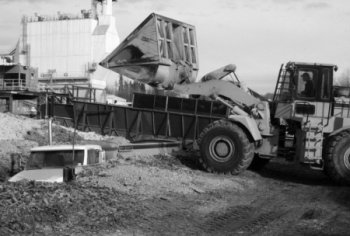
Figure 2. Loading wood ash
Variability in the % CCE of ash from different facilities is due to the degree of combustion achieved in the energy recovery system. In highly controlled energy systems, the liming value of wood ash is relatively constant. However, ash produced in beehive burners is highly variable and has limited potential as a liming material for agricultural soils (Figure 3).
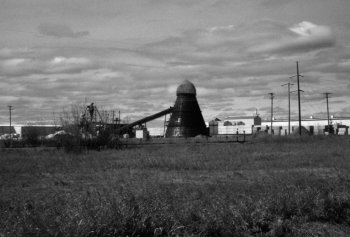
Figure 3. Beehive burner
Fineness
Fineness refers to the particle size of the liming material. The fineness of agricultural lime is determined by weighing a sample, screening the sample and determining the per cent retained on screens of various mesh sizes. Materials passing through a 60 mesh sieve have excellent liming capability; however, some coarser fractions are easier to handle. The reactivity of these size fractions is related to the surface area of the particles exposed to the soil. Materials with small particle size are very reactive because of their large surface area.
Wood ash originating from highly controlled burner systems will consist of very small particle sizes and thus will be very reactive when incorporated into soil. Field studies near Peace River, Manning, Edson and Drayton Valley have shown wood ash is an excellent liming material when compared with agricultural lime.
Moisture content
The moisture content of agricultural lime is usually less than 2 per cent and is therefore not considered when application rates of agricultural lime are determined. Some moisture is desirable to reduce dusting during application. The moisture content of ash varies depending on the process used in the energy recovery system and the length of time the ash is exposed to precipitation before application. Per cent moisture may vary from less than 1 per cent for recently produced ash to more than 10 per cent when water is added to cool the ash and reduce the fire risk.
When ash is recovered from a landfill or an outdoor storage facility, an assessment of the extent of wetting should be made. In most instances, moisture penetration into the pile is relatively shallow, and when the moisture is mixed with underlying materials, its effect on liming value is minimal.
Longevity of Lime
No studies exist to show the long-term benefit of using ash as a liming material. A trial was established in west-central Alberta in 1970 using agricultural lime. There continued to be a significant increase in yield of barley until 1993 when trial monitoring was discontinued (Figure 4). Since the mode of activity of ash is similar to that of agricultural lime, it is believed the long-term benefit of ash would be similar to that of agricultural lime.
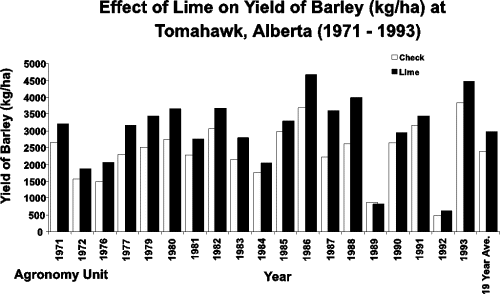
Figure 4. Effect of lime on yield of barley at Tomahawk, Alberta
Other Wood Ash Benefits
The objective of most research studies with agricultural lime and wood ash was to evaluate the potential use of ash to increase soil pH and thus increase the yield of acid sensitive crops. Some research was conducted to show the effect of liming materials on soil tilth, and research is currently underway to investigate the availability of phosphorus in wood ash. The following is a brief discussion of the other benefits of liming.
Tilth
Farmers have often observed an improvement in soil tilth after liming, particularly on soils low in organic matter (Luvisolic soils) or soils high in sodium (Solonetzic soils). Farmers observed that after liming, soils are less prone to crusting, have reduced power requirements for tillage, and water entry into the soil is greater.
This improvement in soil tilth is due to the ability of calcium to bind individual sand, silt and clay particles into stable soil aggregates. In more productive soils, such as those in the Black soil zone, organic matter is primarily responsible for maintaining stable soil structure. Soils with stable structure are also well aerated, which is particularly important for optimal nitrogen fixation by legumes.
Research conducted by Agriculture and Agri-Food Canada shows increases in the yield of canola and barley when two soils near Valleyview were limed to pH 5.5, 6.0, 6.5, 7.0 and 7.5. Increases in yield due to reduced soil acidity would not be expected above pH 6.0 since canola and barley are moderately tolerant of soil acidity. The researchers attributed the yield increase to improved soil tilth. It is believed this improvement in soil tilth would be a long-term benefit of liming.
Soil fertility
As trees grow, plant nutrients are absorbed from the soil and are incorporated into plant tissue. When hogfuel is burned, most of the nitrogen and sulphur are released into the atmosphere while much of the phosphorus and potassium is retained in the ash. When ash is applied to soil, a significant amount of plant nutrients are also added to the soil.
Liming may improve soil fertility by several mechanisms. An increase in soil pH may increase the decomposition rate of soil organic matter by soil bacteria and thus speed up the rate of release of plant nutrients such as nitrogen. This temporary benefit may be observed for two or three years after liming.
Liming acid soils increases phosphorus availability. Below pH 6.0, iron and aluminum reduce phosphorus availability. Over-liming may also reduce phosphorus availability as well as that of the micronutrients. Above pH 7.0, calcium and magnesium precipitate phosphorus to form compounds of low solubility, which means reduced availability for crop growth.
Research recently completed in Alberta shows that most soils are deficient in phosphorus. A significant amount of phosphorus is added to soil when ash is applied. Field research shows phosphorus soil test values increased after liming with Ash also contains a substantial amount of potassium that would be beneficial on potassium-deficient soils. Increased crop growth may also be due to improved availability of sulphur after liming with ash, particularly for crops that have a high sulphur requirement, such as alfalfa and canola. Ash also contains calcium, magnesium and micronutrients; however, most soils have an adequate supply of these nutrients.
Research is underway in central Alberta both to compare wood ash and agricultural lime and to investigate the availability of phosphorus in wood ash when barley and mixed forages are grown. Preliminary results (Figure 5) show ash is an effective liming material, and the availability of phosphorus is greater than previously thought. Crop yield was higher on soils that received wood ash than on soils that received agricultural lime plus phosphate fertilizer. In addition to increased phosphorus fertility, the
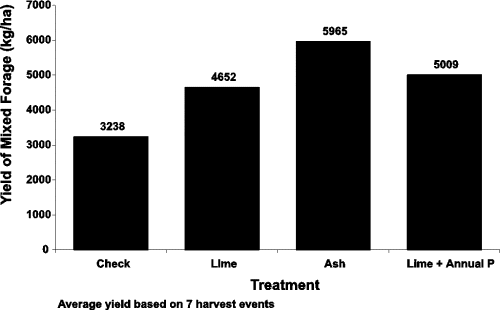
Figure 5. Comparison of Wood Ash, Lime and fertilizer Phosphorous on Forage Yield (1999-2000)
increased yield may also be due, in part, to a more rapid change in soil pH when ash is used. Ash may be the preferred liming material when acid sensitive crops are to be grown soon after the application of a liming material.
The long-term benefit of liming acid soils is well documented; however, the role of the nutrients in ash on crop nutrition is not very well understood. Crop response to a large single application of phosphate fertilizer has persisted for two to three years on soils with a high fixation capacity and for five to ten years or more on soils with a low phosphorus fixation capacity. The long-term benefit of phosphorus and other nutrients in ash needs to be assessed on typical acid soils in Alberta.
Weed control
Weed encroachment into crop land may occur when the competitive ability of the crop is reduced because of unfavourable crop growing conditions. Research has shown that increasing soil fertility reduced the severity of infestations of ox-eye daisy, wild caraway, dandelion, Canada thistle, common tansy, yellow toadflax and scentless chamomile. Farmers have observed reduced infestations of scentless chamomile and corn spurry after liming. The use of ash as a soil amendment provides a unique opportunity to increase the competitive ability of crop growth by increasing soil pH and increasing soil fertility.
Application of ash
When ash is used as a liming material, special attention must be given to the following:
- soil sampling
- the lime requirement test
- application and incorporation of the ash
A thorough understanding of each factor is essential to achieve the maximum benefit from the use of wood ash.

Figure 6. Wood ash - note fine particle size
Soil sampling
A number of techniques are used to achieve a representative soil sample from the field to be limed. The objective of soil sampling is to determine the variability in a field and to provide lime recommendations for each soil type.
The most common sampling method used is random sampling of homogenous units within a field. This method is the traditional approach used in agriculture. A field is divided into sampling units based on topographic position (knolls, mid-slopes and depressional areas), differences in soil colour, soil texture (per cent sand, silt and clay in the soil) and per cent organic matter. From each unit, a composite topsoil sample (0 to 6 in.) is obtained by randomly sampling the soil at 15 to 20 locations.
Lumps must be broken, the sample mixed and a small sub-sample taken and air-dried before submitting the sample to an accredited laboratory for analysis. Moist samples may be shipped directly to a laboratory providing the time in transit is short. Laboratory personnel will dry these samples before analysis. Samples from the 6 to 12 in. and 12 to 24 in. depths should also be obtained to help identify other crop production limitations.
Soil analysis
When samples are submitted for a lime requirement, the analysis must be done using the incubation method. This method is recommended by Alberta Environment. The lime requirement is converted to an ash recommendation by the following calculation.
Rate of ash required =
100/CCE of the ash-a X 100/100 - % H20-b X Lime requirement (tonnes per acre)-c
Where:
-a CCE refers to the calcium carbonate equivalence of the wood ash. CCE is a measure of purity of the ash and is available from the generator of the wood ash. -b Refers to per cent moisture in the ash and is available from the generator of the ash. -c is the lime requirement as provided by the soil testing laboratory. If recommendations are made in metric measure, the appropriate corrections must be made if imperial measures are the preferred units.
| Example | Lime requirement is 3 tonnes per acre.
CCE of ash is 65%
Per cent moisture is 5% |
Rate of ash required =
100/ 65 X 100/(100 - 5) X 3 tonnes per acre
= 4.8 tonnes per acre
Application
Wood ash can be applied with any equipment that provides a uniform coverage over the soil surface (Figure 7). Lime spreaders can be used, and many of the newer models of fertilizer spreaders can also spread wood ash.
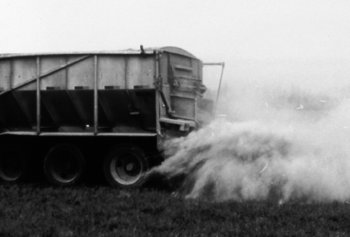
Figure 7. Spreading wood ash
Wood ash should be incorporated into the soil. Incorporation should be done within a reasonable time to minimize dusting from wind or removal by water flowing over the soil. Application of ash to perennial forage is not recommended since incorporation is not possible. Agricultural lime and, to a lesser extent, wood ash is relatively insoluble and hence, immobile. Movement into the soil without soil tillage is minimal, so the benefits of ash would not be realized when it is applied to perennial forages.
Wood ash must not be applied in locations that likely would result in contamination of surface or groundwater. Ash should not be applied within 50 metres of water wells or permanent bodies of water, nor should it be applied to frozen soil or under any conditions where incorporation within three days is not possible.
Wood ash is a very caustic material. As with the handling of other agricultural chemicals, proper protective equipment should be worn to protect the health of the applicator.
Regulatory Approval
The Alberta Forest Products Association, in conjunction with Alberta Environment and Alberta Agriculture, is developing guidelines for spreading energy system wood ash on agricultural land. It is anticipated that these guidelines will be completed and accepted by Alberta Environment early in 2002.
In the interim, authorization to spread ash is provided to eligible forestry facilities on an annual basis. The terms and conditions of this authorization are similar to those contained in the draft guidelines under development.
Other Sources of Information
Additional information on the management of acid soils is contained in the following factsheet:
Liming Acid Soils, Agdex 534-1
Prepared by:
Jerome Lickacz
Pulse and Oilseed Unit,
Alberta Agriculture, Food and Rural Development
Source: Agdex 534-2. February 2002. |
|